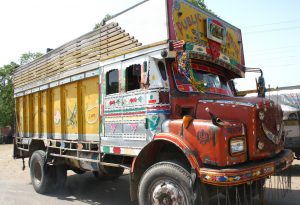Any person that has spent some time travelling on Indian roads must have noticed the ubiquity of goods trucks, a sure indication of their economic importance. With the colorful ways in which they are adorned and the diversity of mottos painted on them, an Indian truck is like a tableau-on-wheels. Each vehicle may – though does not have to – tell us about the religion, caste, linguistic community and life philosophy of the driver (a subject I’ve written about for The Diplomat). These trucks are a travelling thumbnail sketch of India’s cultural microcosm.
But it was also unfortunately not difficult to see some of them wrecked in the most horrible ways, sometimes completely destroyed and deformed, lying by the road or at the bottom of mountain slopes. One can only ponder how significant the work of Indian truck drivers is for the country’s economy while their lives remain in constant peril because of the work they are doing.
A 2018 study of over 1,000 Indian truck drivers by Kantar found that 50 percent “have trips where duration is over 12 hours” while 46 percent “drive continuously for over six hours with no break.” And yet they keep rushing – not only to deliver their goods on time, but also to earn their small margins. The drivers’ work is typically taken advantage of by brokers, private companies and the state, all of which, in their own ways, eat into the profits. This causes drivers to constantly overload their machines (to earn more) and risk longer trips to go around tax points (to lose less). Or, to be blunt: The fate of Indian truck drivers is similar to that of most of the Indian working class, they do most of the hard churning, while others drink the cream of the work.
Is there anyone to tell their story? A new arrival on this narrative scene is a book by an Indian journalist, Rajat Ubhaykar: Truck de India!: A Hitchhiker’s guide to Hindustan. The author spent months with Indian truck drivers, travelling all the way from his home, Mumbai in the west of India, to Kashmir in the northwest and Manipur in the northeast, and down to the extreme south of the subcontinent, spending endless hours talking to drivers, taking notes and turning his work into a printed documentary.
It is an extremely well-written and colorful account and yet also a gloomy one. Ubhaykar tells us of the drivers’ woes mentioned above – and much more. His heroes bribe officials and policemen to get going, watch out for militants in volatile areas, eat and sleep in their trucks (sometimes also by the wheel). Indeed, for most of the days of the year their truck is their travelling home. Women usually do not wish to marry truck drivers – one of the heroes of the story tells us – as they spend more time away than at home. And yet, as seen in the book, there are whole villages in India where truck driving has become the predominant profession of the men, one of the ways to escape the dire poverty of rural areas.
As with the way Mayank Austen Soofi described the life of Delhi’s female sex workers in his Nobody Can Love You More, Ubhaykar neither demonizes nor glorifies his subjects. They are just people, with their compulsions, needs and dreams. They need alcohol, music, sex and the other small joys of life to make their long hours by the wheel bearable. Moreover, somewhat similarly to Ravi Agarwal’s India Connected, Ubhaykar does not imprison India in standard clichés (of a never-changing, inward-looking country focused only on its spirituality and ancient past). It shows Indians on the move, both literally and symbolically. One of those little joys the drivers can afford while travelling is surfing the net and listening to music on their phone; some have also started consulting Google Maps for directions. And while they mostly prefer to avoid contact with state authorities, the book mentions a few scattered cases where the work of the government has made the life of the trucker community somewhat easier.
Truck de India! is a thorough picture, with no attempt to cut out the dark sides from the frame. The Indian goods truck industry – one of the key vehicles of the country’s freight – is surrounded by an entire ecosystem. It is not limited to the people that want to sell their goods and those that want to buy them, the freight companies, but also includes the agents and the brokers, all of this capped by the authority of the state. And then there also all of those that bite away chunks of the drivers’ income pie as they transport it through the country: the policemen, the officials, the militants and the bandits. But there are also those that live off the trucking industry through hard work and little profit (like the truckers themselves): the employees at small restaurants, the laborers at truck manufacturing facilities and, yes, the prostitutes.
Taking a long shot at a generalization, I could insist that the goods trucks symbolize a part of contemporary India as such, with all its strengths and weaknesses. Faced with poor infrastructure, inadequate governance and unavoidable corruption, and yet propelled by the ever-growing consumer market, its drivers, like much of the country’s working class, display an inspiring resilience to harsh circumstances, tremendous imagination to improvize and great cleverness in bypassing rules, all of this while wearing their culture and patriotism on their sleeves. And just like its good trucks, India, though challenged with so many problems and despite all odds, somehow continues to move on, up its own road.
































